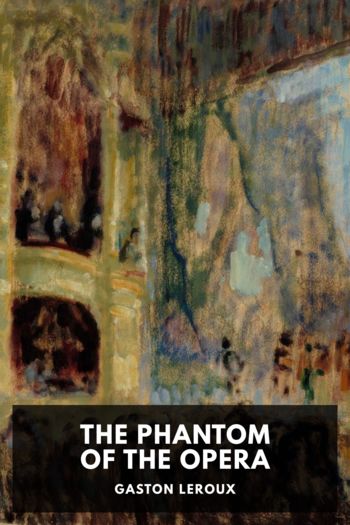The Phantom of the Opera, Gaston Leroux [primary phonics books txt] 📗

- Author: Gaston Leroux
Book online «The Phantom of the Opera, Gaston Leroux [primary phonics books txt] 📗». Author Gaston Leroux
In those days, it was still part of the firemen’s duty to watch over the safety of the Opera house outside the performances; but this service has since been suppressed. I asked M. Pedro Gailhard the reason, and he replied:
“It was because the management was afraid that, in their utter inexperience of the cellars of the Opera, the firemen might set fire to the building!” ↩
Like the Persian, I can give no further explanation touching the apparition of this shade. Whereas, in this historic narrative, everything else will be normally explained, however abnormal the course of events may seem, I can not give the reader expressly to understand what the Persian meant by the words, “It is someone much worse than that!” The reader must try to guess for himself, for I promised M. Pedro Gailhard, the former manager of the Opera, to keep his secret regarding the extremely interesting and useful personality of the wandering, cloaked shade which, while condemning itself to live in the cellars of the Opera, rendered such immense services to those who, on gala evenings, for instance, venture to stray away from the stage. I am speaking of state services; and, upon my word of honor, I can say no more. ↩
All the water had to be exhausted, in the building of the Opera. To give an idea of the amount of water that was pumped up, I can tell the reader that it represented the area of the courtyard of the Louvre and a height half as deep again as the towers of Notre Dame. And nevertheless the engineers had to leave a lake. ↩
These two pairs of boots, which were placed, according to the Persian’s papers, just between the set piece and the scene from the Roi de Lahore, on the spot where Joseph Buquet was found hanging, were never discovered. They must have been taken by some stage-carpenter or “door-shutter.” ↩
An official report from Tonkin, received in Paris at the end of July, 1909, relates how the famous pirate chief De Tham was tracked, together with his men, by our soldiers; and how all of them succeeded in escaping, thanks to this trick of the reeds. ↩
Daroga is Persian for chief of police. ↩
The Persian might easily have admitted that Erik’s fate also interested himself, for he was well aware that, if the government of Teheran had learned that Erik was still alive, it would have been all up with the modest pension of the erstwhile daroga. It is only fair, however, to add that the Persian had a noble and generous heart; and I do not doubt for a moment that the catastrophes which he feared for others greatly occupied his mind. His conduct, throughout this business, proves it and is above all praise. ↩
It is very natural that, at the time when the Persian was writing, he should take so many precautions against any spirit of incredulity on the part of those who were likely to read his narrative. Nowadays, when we have all seen this sort of room, his precautions would be superfluous. ↩
Even so, I am convinced that it would be easy to reach it by draining the lake, as I have repeatedly requested the Ministry of Fine Arts to do. I was speaking about it to M. Dujardin-Beaumetz, the undersecretary for fine arts, only forty-eight hours before the publication of this book. Who knows but that the score of Don Juan Triumphant might yet be discovered in the house on the lake? ↩
See the interview of the special correspondent of the Matin, with Mohammed-Ali Bey, on the day after the entry of the Salonika troops into Constantinople. ↩
ColophonThe Phantom of the Opera
was published in 1910 by
Gaston Leroux.
It was translated from French in 1911 by
Alexander Teixeira de Mattos.
This ebook was produced for
Standard Ebooks
by
Jason Bell,
and is based on a transcription produced in 2008
for
Project Gutenberg
and on digital scans available at the
Internet Archive.
The cover page is adapted from
Sisäkuva Suomalaisesta Oopperasta,
a painting completed in 1919 by
Magnus Enckell.
The cover and title pages feature the
League Spartan and Sorts Mill Goudy
typefaces created in 2014 and 2009 by
The League of Moveable Type.
The first edition of this ebook was released on
January 29, 2020, 4:59 a.m.
You can check for updates to this ebook, view its revision history, or download it for different ereading systems at
standardebooks.org/ebooks/gaston-leroux/the-phantom-of-the-opera/alexander-teixeira-de-mattos.
The volunteer-driven Standard Ebooks project relies on readers like you to submit typos, corrections, and other improvements. Anyone can contribute at standardebooks.org.
UncopyrightMay you do good and not evil.
May you find forgiveness for yourself and forgive others.
May you share freely, never taking more than you give.
Copyright pages exist to tell you can’t do something. Unlike them, this Uncopyright page exists to tell you, among other things, that the writing and artwork in this ebook are believed to be in the U.S. public domain. The U.S. public domain represents our collective cultural heritage, and items in it are free for anyone in the U.S. to do almost anything at all with, without having to get permission. Public domain items are free of copyright restrictions.
Copyright laws are different around the world. If you’re not located in the U.S., check with your local laws before using this ebook.
Non-authorship activities performed on public domain items—so-called “sweat of the brow” work—don’t create a new copyright. That means nobody can claim a new copyright on a public domain item for, among other things, work like digitization, markup, or typography. Regardless,





Comments (0)